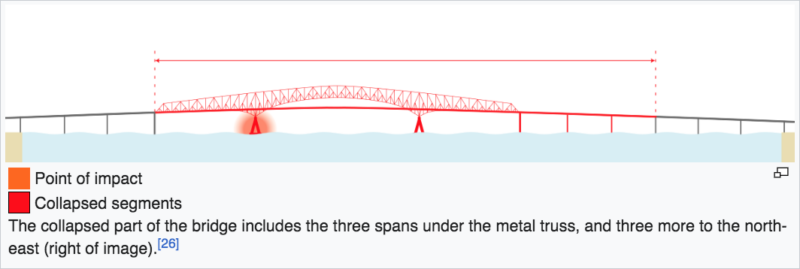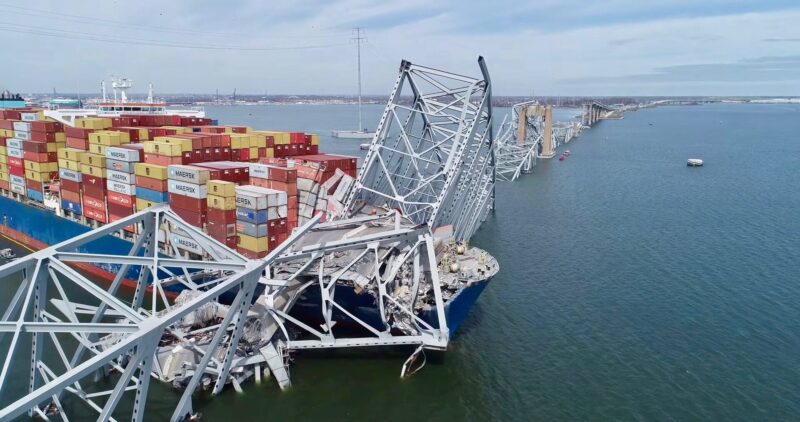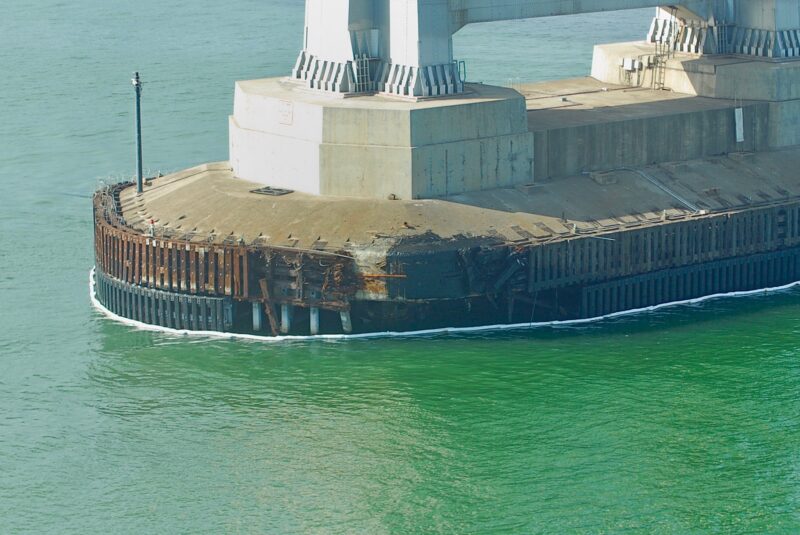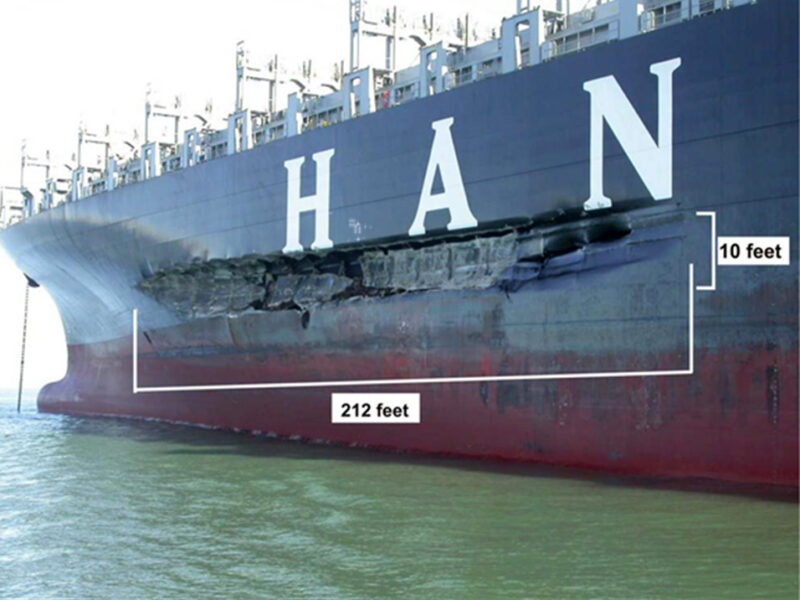
Hobbled Cargo Ship Destroys Francis Scott Key Bridge in Baltimore
In what will likely go down as one of the worst accidents in maritime history, the one-and-a-half-mile-long Francis Scott Key Bridge in Baltimore was demolished early Tuesday morning after an apparently powerless container ship struck a support column. At least six people are presumed dead, and a major interstate spanning the Patapsco River linking to one of the East Coast’s largest ports has been severed indefinitely.
It’s still not clear why the 985-ft container ship Dali — owned by the Singapore-based Grace Ocean Private Ltd — was hobbled and apparently drifted into the Francis Scott Key Bridge. The Dali had just departed from the Port of Baltimore when it lost power and issued a mayday call, according to the New York Times. “Radio traffic from emergency workers suggested that the crew was struggling to steer the ship, according to audio published by Broadcastify. Most of the lights of the ship went dark abruptly, just over two minutes before the ship hit the bridge.”
Investigators have retrieved the vessel’s voyage data recorder, or the “black box,” and hope to create a timeline of events, the Times said. Maryland governor Wes Moore said there were no indications of terrorism or a deliberate attack on the bridge.
There will be long, protracted investigations, lawsuits and years spent in court trying to adjudicate blame for and seek remuneration for this horrifying accident. There are already questions about the labor practices of the shipping company and the fail-safes around the bridge itself — as well as protection on other bridges around the country, especially here in the Bay Area. Speculation, finger-pointing and a few conspiracy theories will no doubt fill the vacuum in the absence of facts.
Even when a timeline is established and the exact causes are known, what remains will be a tragic loss of life, the severe impairment of a major transportation hub, and the catastrophic, unfathomable loss of major infrastructure.

The vessels belonging to Grace Ocean Private Ltd “have been cited in recent years for labor violations, which include underpaying ship crews and holding crew members onboard for months past their contracts, according to the Australian Maritime Safety Authority,” the New York Times reported. One Grace Ocean ship was detained in 2021 because “management was in arrears paying 13 crew members and had kept them on the ship for more than 12 months.” Another ship reportedly had had 10 seafarers aboard for more than 14 months.
The infractions were “serious and shameful violations of an international convention on maritime labor,” an Australian official said in 2021. “This type of behavior is unethical and in complete contravention to the Maritime Labor Convention,” the official was quoted as saying. “The international conventions that protect seafarers’ rights are very clear.”
“The extremely opaque nature of global ship-owning makes finding the ultimate owners and holding them accountable for any violations difficult,” the Times wrote. The lineage of ownership for Grace Ocean is a rabbit hole of companies based in the British Virgin Islands and Hong Kong.

The New York Times said that there were “no obvious fender system” around the supports of the Francis Scott Key Bridge, and cited photos of other structures that had rock walls, island barriers or large “fender walls” (our term) to create a safety buffer between a potentially wayward ship and the foundation of a bridge.
SFGATE reported that the Bay Area’s major bridges all have systems in place to protect them from collisions with ships. The Golden Gate Bridge “has the most robust protection system of any bridge on the West Coast,” a spokesperson from the state agency that manages the bridge told SFGATE. Readers will no doubt recall when the Cosco Busan struck the Bay Bridge in 2007 and spilled more than 53,000 gallons of oil.


Want to make a friend smile? Give them a gift subscription to Latitude 38.

While working for Jeanneau America out of Annapolis Maryland, I picked up our sailboats by water from the Port of Baltimore and Seagirt terminals seen with their cranes behind the collapsed bridge. I literally picked up close to 200 boats this way passing beneath this bridge. It must have been known that this bridge was vulnerable as following 9/11 there were ALWAYS two large tugs stationed close to the bridge to help avert a strike.
As an aside, about 100 meters north of the bridge is a small nun buoy painted to look like a little revolutionary soldier. This was a marker reportedly to show where Francis Scott Key was anchored during the famous battle while penning the words to our National Anthem.
Jeff, great anecdote about Francis Scott Key. It’s hard to imagine what would happen to the Bay Area if access to the Port of Oakland was disrupted by a similar incident. The systems we’ve created to allow us to enjoy our lifestyle can quickly feel very fragile. The ripple effects from all these events are hard to imagine and can be very long-lasting. Have you backed up your computer today and put chafe gear on your docklines?
Well, I’m certainly not an expert – I’ve never left a harbor on more than an outboard – but I have to ask what a ship of that tonnage was doing leaving the dock headed thousands of nautical miles to Siri Lanka with major systems incapable of getting it safely out of harbor. Even if she had gotten past the Key Bridge, this kind of power failure would have been a hazard to the crew, coastlines and navigation. A shameful placing of profit over safety.
Could the engine failure be due to the fuel that ships have to use while in the harbor, less polluting, instead of the fuel they use outside of the harbor. My second question is whether there were some tugboats ensuring that the ship stays on her tracks?
Anybody out there know how a container ship diesel engines – more than one presumably- could just quit? Once diesels start they require no spark so what would cause them to just stop? Fuel pump(s) failure?coolant failure?